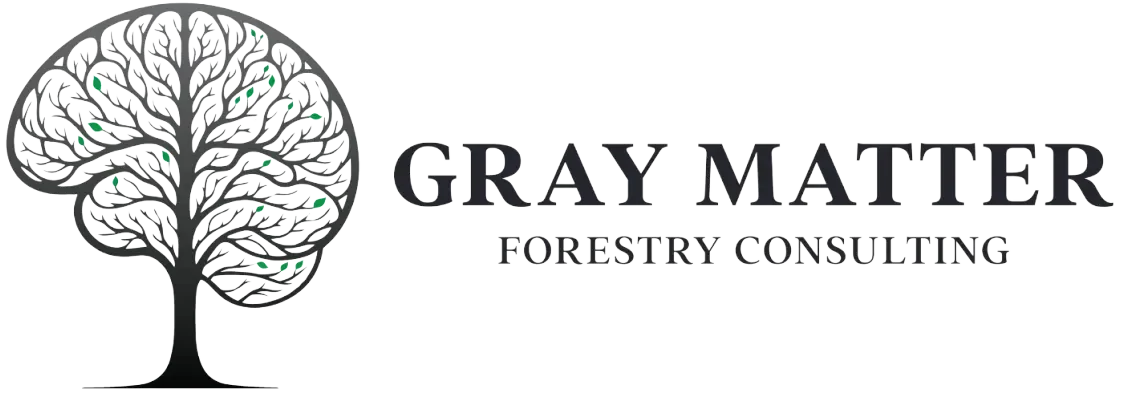Expert Guide to Protecting the GTA’s Urban Forest During Construction
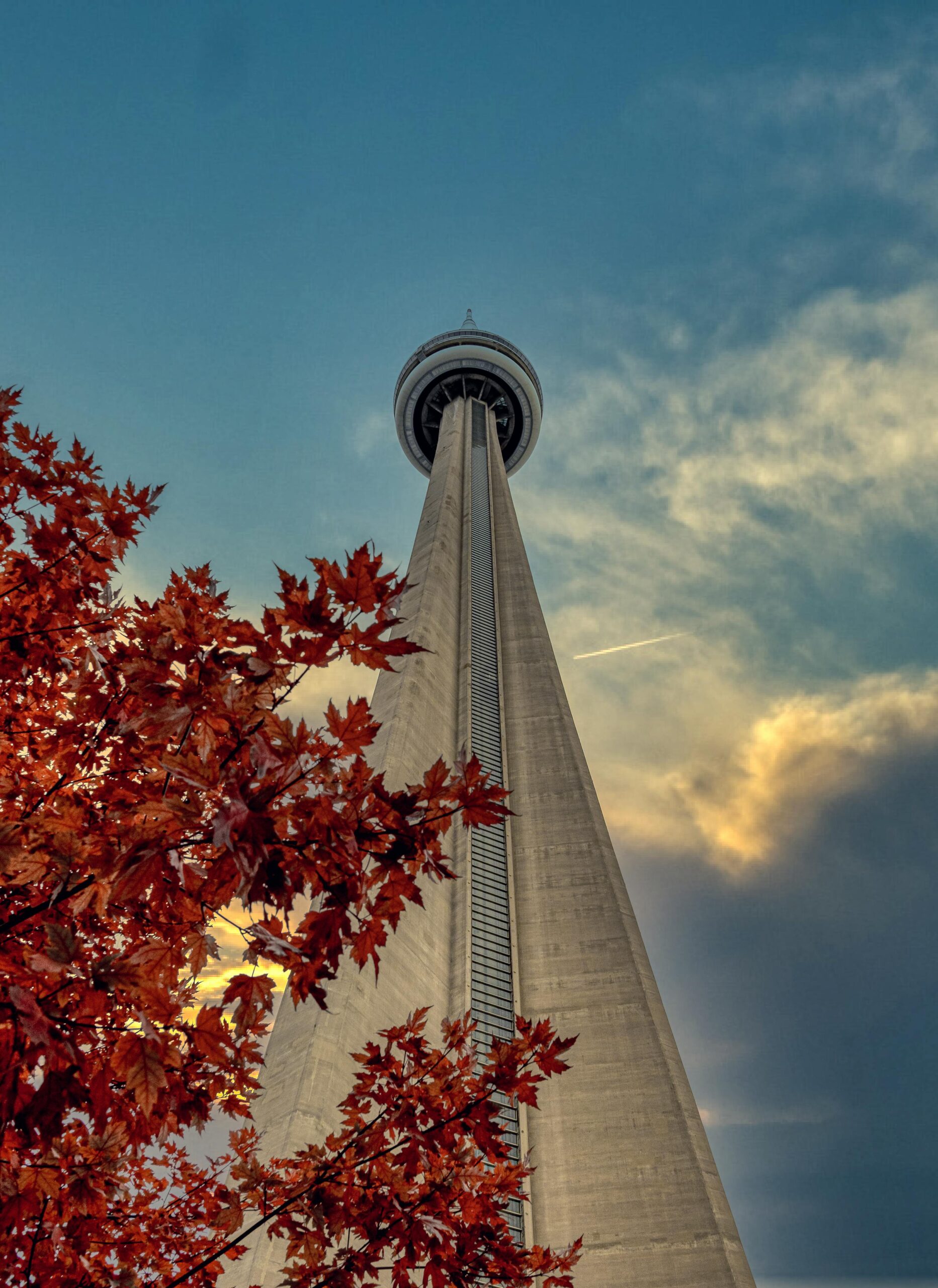
“The future of sustainable and inclusive cities will surely depend
on how we tend to and protect our urban trees.”
World Economic Forum , 2022
What you’ll learn about tree Protection and construction in the Greater Toronto area
If you’re planning a construction or renovation project in Toronto and the Greater Toronto Area (GTA), consider the tree protection laws from the outset. It could save you hours of frustration and thousands of dollars in penalties and rework fees.
Protecting trees isn’t just about meeting regulations—it’s about avoiding costly delays, enhancing property value, and creating sustainable, attractive spaces. Shade, reduced energy costs, and improved curb appeal are just a few of the many ways that trees increase property values and quality of life in cities. However, without proper planning, construction can cause irreversible damage to these valuable assets.
This guide is for designers incorporating trees into a site plan, contractors managing construction logistics, and property owners balancing development with greenery. It offers practical and proven strategies to integrate tree preservation into your project from start to finish.
Specifically, you’ll learn how to:
- navigate Toronto’s tree protection bylaws and regulations
- implement a Tree Protection Plan (TPP)
- avoid common mistakes that lead to unexpected fines or tree loss.
- enhance property value through strategic tree preservation
- create sustainable, attractive spaces that benefit from a mature tree canopy
The goal is to help you protect trees while keeping your project on track and compliant.
Toronto’s Tree Protection Framework
Tree preservation is a cornerstone of Toronto’s urban development policy. The City of Toronto has set a target of 40% canopy cover to maintain high livability standards. This amount of cover is believed to produce the full range of environmental, economic and community services that trees can provide.
To achieve its lofty goal, the city has created strict protections for trees on public and private land to maintain the urban forest while supporting responsible development.
These regulations are set out in two key documents:
Other municipal and urban governments within the GTA have implemented their own tree preservation bylaws and regulations, so project designers and property developers need to become familiar with their local requirements.
The Business Case for Tree Protection
Trees are valuable assets that contribute significantly to property worth and urban quality of life. Research shows that trees can lead to higher sale and rental prices. One study found that even a 1% increase in tree cover can boost property values by a corresponding 1%.
Here are a few of the proven benefits that trees provide in urban communities:
- Improved air quality: Trees remove air pollutants, reducing the risk of respiratory problems and asthma
- Enhanced mental health: Exposure to trees decreases anxiety, depression, and stress levels
- Increased physical activity: Urban trees are linked to higher physical activity levels, leading to decreased obesity and improved cardiovascular health
- Temperature regulation: Trees reduce summer air temperatures by 2-4° Fahrenheit on average, mitigating heat-related health risks
- Energy conservation: Trees provide shade and reduce energy usage for cooling in buildings
- Stormwater management: Urban forests promote beneficial water quality and reduce stormwater management costs
- Carbon sequestration: Trees absorb and store carbon dioxide, helping to mitigate climate change
- Increased property values: Communities with healthy tree cover attract new residents, industry, and commercial activity.
- Noise reduction: Trees block or absorb noise from the urban environment
Using This Guide
The following sections walk you through the six phases of tree preservation in construction:
Each section provides actionable steps, technical requirements, and professional insights to help you implement effective tree preservation strategies. For specific permit requirements, visit the City of Toronto’s tree permit application portal.
Tree preservation can be achieved without compromising project goals. The following sections will guide you through this integration process, beginning with the planning phase.
Phase 1: Planning for Tree Protection Success
Frequently, the landscape element of a construction project is designed and installed last. Without regulation, tree protection planning is frequently not considered or, at best, gets fitted in “where possible.” The green elements of the plan are easily viewed as expendable.
Tree protection is a mandatory aspect of the construction permitting process in many urban and suburban areas across Canada, including most communities in the Greater Toronto Area (GTA). Property owners and developers who fail to incorporate tree protection plans during a project’s initial phases may pay dearly later.
Construction permit applications that don’t meet the local tree protection standards may be sent back for rework, which can lead to delays and extra costs. Sometimes, the applicant must abandon the project entirely.
Proactive Planning
Proactively incorporating tree preservation during the planning phases of a project can avoid those costly delays. It helps ensure compliance with the tree protection regulations.
Steps in the Planning Phase
1. Tree Resource (Inventory)
A tree inventory is the first step in understanding the site’s natural assets. A detailed inventory provides:
- Tree species, size, health.
- Tree location- Toronto’s regulations require inventories to include all trees within 6 meters of the project boundary to ensure comprehensive planning.
- Identification of trees protected under Toronto bylaws and the Ravine and Natural Features Protection Bylaw within the larger Toronto bylaw.
- Any notes concerning the trees, such as defects, poor form, and existing conflicts with built infrastructure.
2. Preliminary Tree Protection Plan
This step is often skipped with the idea of saving time or money or perhaps as an oversight. This is a mistake because the preliminary plan will find conflicts with the proposed design early on, when they can be easily addressed before formal drawings are created.
For example, soil excavation is one of the most common issues addressed in tree protection plans. Equipment movement causing compaction over tree roots and root damage from digging are primary tree protection concerns. The arborist can advise designers on ways to address these design issues.
3. Construction Permit Application Package
a. Tree Protection Plan (TPP)
The TPP is a formal document required as part of the construction permit application. Tree regulations enforcement staff will review the TPP to ensure proper precautions have been planned and effectively communicated.
TPPs are diagrams that show the existing trees on a property at the time of a permit application. Trees are shown in relation to the planned construction on a site plan.

TPPs include:
- Tree Inventories: Detailed assessments of tree species, size, and condition.
- Tree Protection Zones (TPZs): These zones define clear boundaries to shield trees from construction impacts. Toronto mandates specific TPZ distances based on tree diameter to ensure that critical roots and soil remain undisturbed. No construction, grade changes, or material storage are allowed within this critical root area without a permit.
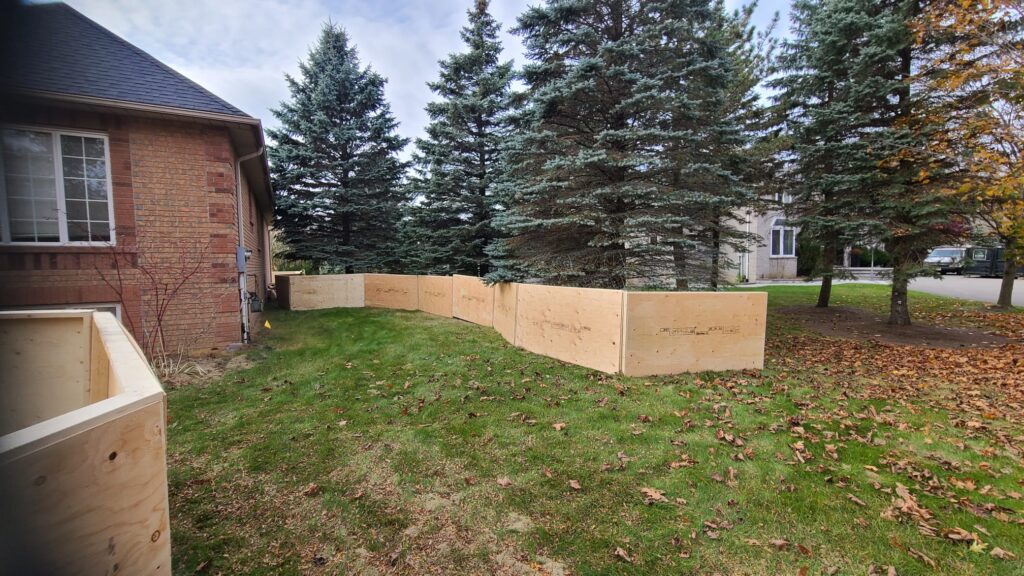
- Any special notes or recommendations the arborist may provide to ensure satisfactory tree protection.
b. Replanting Plan
When required by the city, replacement trees may need to be shown on a separate drawing of the same site plan. Important details include:
- Location, species, and calliper (diameter given by the nursery). Toronto requires replacement trees to be at least 50 mm in caliper for deciduous trees and 1.75 to 2.5 metres in height for coniferous trees.
- The time of replanting (typically the next spring or fall planting season in the year) after construction, whichever is earlier.
c. Arborist Report
The Arborist Report document communicates all the Tree Protection Plan (TPP) details and addresses any concerns or grey areas arising from the design.
4. Evaluating Suitability for Preservation
Not every tree needs to be preserved under the tree bylaws. The following criteria are used to determine which trees must be protected and which trees should be removed.
- Proximity to planned construction: Healthy trees that do not conflict with “as of right” development usually won’t be approved for a removal permit. Plan revisions will be needed if the permit request is rejected.
- The structural stability and health of each tree are considered. Sometimes, a tree is already in decline or showing serious structural instability that would present a safety hazard to construction crews or site end users. Such trees are often better off removed since the liability of keeping them is too great. It should be noted that this is not the usual condition of a tree. Most trees are perfectly sound and just need some special consideration before construction begins.
- Species tolerance to construction stress. Not all trees react the same way to disturbances such as grading, soil compaction, root cutting, and changes in water availability. Some species are highly resilient, while others are extremely sensitive to environmental changes caused by construction activities. Click here (see page 11) for a list of the sensitive species.
- Longevity and ecological value are important criteria that influence whether a tree is worth saving.
The project details may require that a tree be cut down based on these criteria, and the regulators recognize this. Their main goal is to preserve trees that should be preserved and replace those that should be removed. Their goal is not to get in the way of development, although that does happen sometimes.
5. Tree Appraisal and Bonding
The City of Toronto may require financial securities for protected trees. These bonds ensure that funds will be available to replace or remediate damaged trees. The bond amount is based on the appraised value of the protected tree plus the removal and replacement costs. This expense can be thousands or even tens of thousands of dollars for large trees. Incorporating these costs into the project budget during planning avoids an unpleasant surprise later.
6. Designing for Tree Protection
Site layout and utility planning must reflect tree preservation priorities. Here are some ways to ensure this:
- Where possible, place all excavations for buildings, roads, and utilities outside TPZs.
- Implement low-impact (no dig) construction techniques near sensitive trees.
- Collaborate with arborists and engineers to design solutions that minimize root disturbance.
Avoiding Common Pitfalls
Construction-related damage often stems from a lack of communication or awareness about tree biology.
- Not considering tree protection in the ideation phase of the planning process often leads to costly redesign and new drawings. Minor design changes can often address problems early in the planning process. These adjustments can significantly reduce tree damage and improve the likelihood of tree survival. An arborist might suggest a range of options, such as:
- aligning driveways and walls
- reconfiguring grading
- designing bridging structures such as footings or paving over roots
- rerouting or tunnelling utility lines under roots.
- Not consulting with neighbours when their trees will be affected. More often than not, early and open communication can make for much smoother interactions and fewer problems. A TPP is very good at ensuring tree protection and survivability, which is often enough to put concerned minds at ease.
- Physical Injuries:
- Equipment can scar trunks and break branches, causing permanent damage.
- Root Cutting: Excavations near trees risk severing critical roots, destabilizing and stressing trees.
- Soil Compaction: Heavy equipment can compress soil, reducing its ability to hold air and water essential for root health.
- Preventative measures include:
- exploratory digs using hydro-vac systems or air spades to identify roots before excavation
- barriers to limit equipment movement in root zones.
Communication Matters
A successful tree preservation strategy hinges on collaboration and clear communication among stakeholders—developers, arborists, contractors, and municipal authorities.
An ISA-certified arborist can create productive dialogue with regulatory officials and other stakeholders, especially when conflicts arise. Engaging an arborist early in the process ensures that trees are evaluated for suitability, protection measures are tailored to the site, and all team members understand the importance of compliance.
Summing up
The planning phase is where tree preservation begins. Developers can avoid conflicts, reduce costs, and enhance the value of their projects. They do this by conducting thorough evaluations, setting up protection zones, and designing with trees in mind.
Trees don’t need to be obstacles to development—they’re opportunities to create sustainable and attractive urban spaces (and to flex your design skills).
Phase 2: Integrating Tree Protection into Design
A Blueprint for Sustainable Development
The design phase is where visions turn into actionable plans. This is the time to ensure that tree preservation strategies set out in the construction permit are properly integrated into the project design.
Why Tree Protection Must Guide Design
Trees don’t move, and we accept them as part of the landscape.
It’s the designer’s job to recognize their inherent value and incorporate their presence into the design with intention. This enhances the value, sustainability, and beauty of development projects.
Without proper integration into the design phase, trees are at risk of damage from grading, infrastructure placement, utility installations, and a host of other potentially damaging actions.
Considerations for Tree Protection in Design
1. Incorporating Tree Protection Zones (TPZs)
- TPZs are the cornerstone of tree preservation. TPZ zones:
- Prevent root damage and soil compaction.
- Minimize or eliminate injury to tree trunks and branches.
- Ensure trees have the space they need to thrive during and after construction.
TPZ requirements will be described in the TPP document as part of the Arborist report. These protected areas must be integrated into the design. Most times, TPZ areas are closed off by tree protection fences, preventing access.
Encroachment upon the TPZ areas triggers an injury permit and extra scrutiny by regulatory staff. In Toronto, TPZ requirements are based on tree diameter:
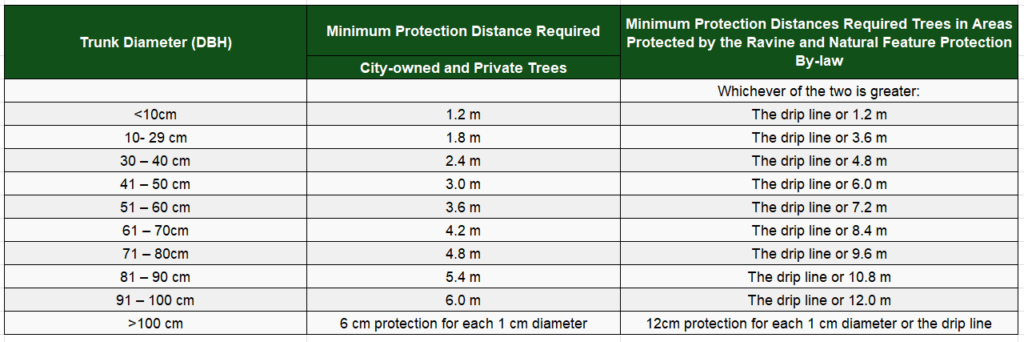
2. Preserving Tree Groups and Ecosystems
Instead of focusing solely on individual trees, consider preserving clusters or stands of trees. Benefits include:
- Shared root systems that enhance stability and resilience.
- Improved microclimates and biodiversity.
- Reduced risk of windthrow
Clusters provide aesthetic and functional value, making them ideal focal points in design.
3. Design Adjustments to Minimize Impact
Collaborate with arborists and engineers to adjust designs for tree preservation. Strategies include:
- Utility Placement: Use tunnelling or directional boring techniques to route utilities under or around root zones.
- Grade Changes: Retaining walls and aeration systems can protect roots from fill or excavation impacts.
- Alternative Foundations: Pile or pier footings are often used to reduce root disturbance for foundations near trees.
If you must excavate in a regulated TPZ, you may require exploratory digs to confirm root locations before excavation. This can be done using a hydro-vac system, an air spade, or hand digging.
4. Incorporating Trees into Landscape Plans
Landscape plans should complement preserved trees rather than compete with them. Key considerations:
- Select plant species compatible with tree root zones.
- Avoid installing irrigation systems that could overwater preserved trees.
- Minimize soil compaction by using non-invasive techniques for planting and landscaping.
5. Hydrology and Soil Management
Changes in site drainage can have profound effects on preserved trees. During the design phase:
- Ensure grading plans do not divert water away from root zones.
- Use permeable surfaces to support natural water infiltration.
- Enhance root health by incorporating soil amendments, such as mulch or compost.
Collaboration is Key
Effective tree preservation during the design phase may require input from a variety of specialists, including arborists, engineers, and landscape architects. Early and frequent communication helps resolve potential conflicts and ensures that tree protection measures align with project goals.
Final Thoughts
Trees are not just obstacles—they’re a design feature that adds value to your project. The design phase is an opportunity to transform tree preservation from a regulatory requirement into a project asset.
Phase 3: Preconstruction Phase – Laying the Groundwork for Success
The preconstruction phase is where plans come to life and the groundwork is laid for successful tree preservation. Developers and landscape architects who prioritize tree protection at this stage set the stage for smoother construction processes and healthier trees.
Preconstruction activities determine how well trees are protected during construction. This phase focuses on physically safeguarding trees, preparing the site, and fostering communication between teams. With protective measures in place, before the first piece of equipment arrives, you minimize risks to tree health and follow regulations.
Steps in the Preconstruction Phase
1. Installing Tree Protection Barriers
Tree Protection Zones (TPZs) must be physically demarcated with barriers (or hoarding) to prevent accidental damage.
- Barriers should be made according to city specifications.
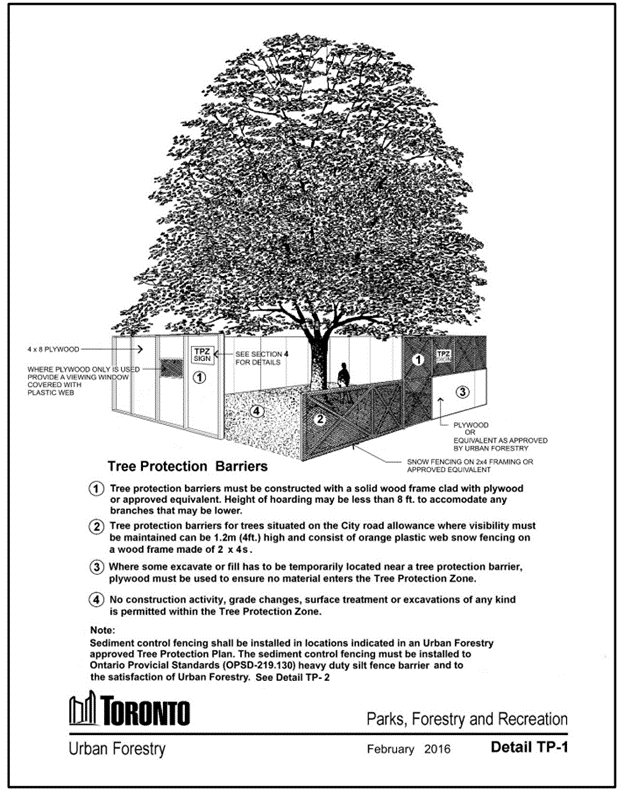
Source: Tree Protection Policy and Specifications for Construction Near Trees (page 13)
- Barriers must remain in place for the duration of the project.
- Clearly mark barriers with signage showing the TPZ and its restrictions, such as prohibitions on material storage or vehicle movement. The city has a standard placard for this purpose.
2. Temporary Construction Access
When construction access within TPZs is unavoidable, protective measures against root and trunk damage must be implemented. Restricted access protocols are the best means of protection.
- Root protection from compaction: Horizontal hoarding, which consists of 3 sheets of ¾” plywood screwed together at 90-degree angles and placed over 12” of mulch.
- Trunk protection: consisting of 4’ lengths of 2×4’s around the stem at risk and held in place with straps.
3. Arboricultural Treatments
Preparing trees for the stresses of construction improves their resilience. Preconstruction treatments include:
- Pruning: Removing deadwood or branches for clearance and structural stability. This may also trigger an injury permit requirement
- Irrigation: Ensure trees are well-watered before site activities alter hydrology.
- Mulching: Apply a 2 to 4-inch layer of mulch to conserve soil moisture and regulate temperature.
- Pest Management: Proactively treating pest or disease issues to improve tree vigour.
4. Exploratory Root Digs
Roots often extend well beyond the visible canopy. When an excavation plan must encroach upon a TPZ, the injury permit often stipulates that an exploratory dig be conducted to find and preserve major roots before excavation begins. Proper root pruning is usually necessary to prevent tearing and decay.
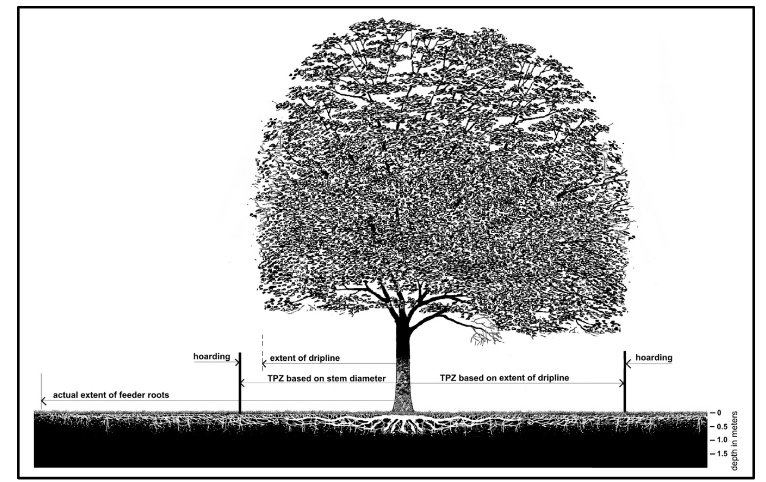
5. Team Coordination and Education
Tree preservation is a team effort. Conduct preconstruction meetings to:
- Educate contractors about TPZ restrictions and penalties for non-compliance.
- Highlight the location of preserved trees and their barriers.
- Establish communication channels for reporting issues or conflicts.
6. Monitoring and Compliance
Once protective measures are installed, they must remain in place until removal is approved by city staff, often after construction is complete. Non-compliance, such as moving barriers or unauthorized root cutting, can lead to significant fines and project delays.
Note: Toronto requires Urban Forestry inspections to approve tree protection measures before construction begins to ensure compliance with local policies.
Summing up
The preconstruction phase is the bridge between planning and execution, where proactive measures can make or break tree preservation efforts. By investing time and resources in this phase, you safeguard the health of urban trees and the success of your project.
Phase 4: Construction Phase – Staying on Track
The construction phase is where tree protection plans are put to the test. Heavy machinery, excavation, and a flurry of site activities can create significant risks for even the most carefully protected trees.
The high-stakes stage
This is a high-stakes period where a lack of care and attention can cause irreversible damage from root severing, soil compaction, and trunk injuries. Following the tree protection regulations helps keep the project on track while successfully preserving the trees through this hectic process.
Steps to Protect Trees During Construction
1. Enforce Tree Protection Zones (TPZs
Maintaining TPZ barriers is needed to prevent unauthorized access and protect roots, trunks, and crowns. Requirements include:
- No construction activities, material storage, or vehicle movement within the TPZ. This includes washing tools and dumping garbage or waste materials.
- Barriers must remain intact and may be inspected regularly for compliance.
- When work is unavoidable near a TPZ, alternative methods like tunnelling or bridging must be employed.
- Note: Toronto mandates signage on all TPZ barriers to ensure clear communication about restrictions.
2. Manage Root Impacts
Excavation near trees often threatens critical roots. Strategies to mitigate root damage include:
- exploratory digs: Using hydro-vac systems, air spade, or hand digging to find roots before excavation.
- root pruning: Clean cuts performed by arborists prevent tearing or decay.
Note: Toronto requires arborist supervision for any root pruning inside the TPZ to ensure minimal stress to trees.
- Alternative Techniques: Tunnel under roots or reroute utilities to avoid disruption.
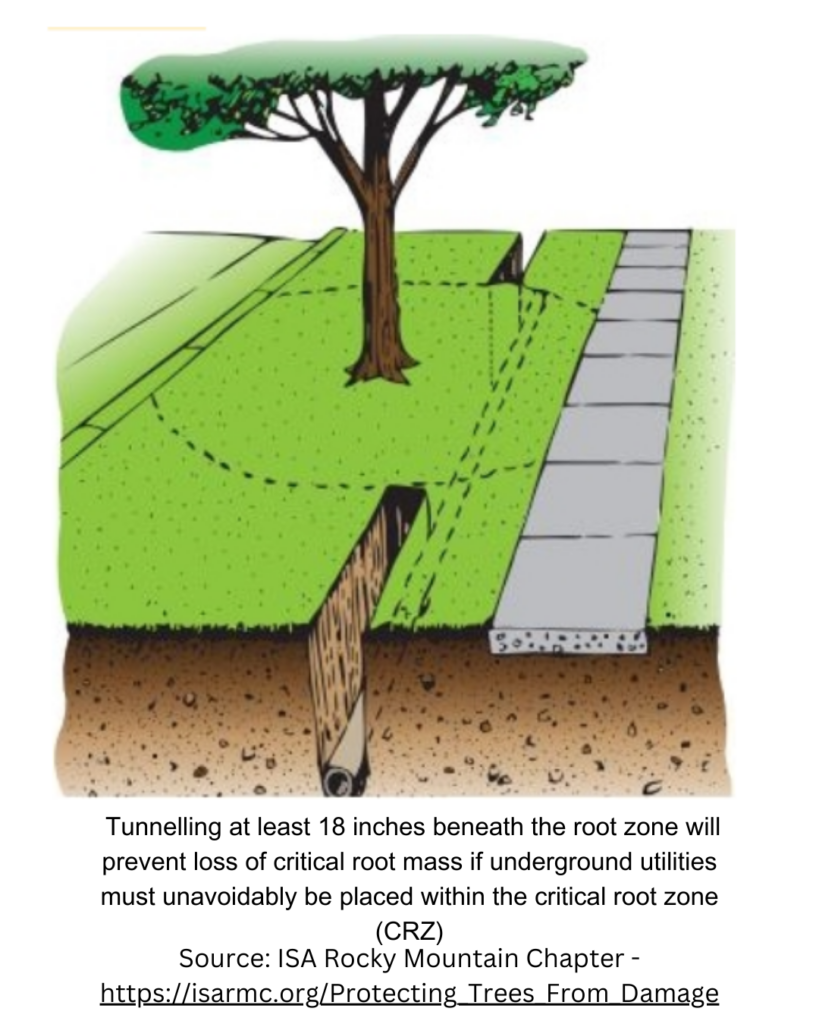
3. Monitoring Irrigation and Hydrology
Construction activities often alter site drainage, changing water availability for trees. Construction plans should account for this by considering:
- Installing temporary irrigation systems, such as soaker hoses or drip lines.
- Monitoring soil moisture levels to prevent drought stress.
- Ensuring grade changes do not divert water away from root zones.
4. Regular Site Monitoring and Reporting
Continuous monitoring by an arborist ensures that tree protection measures stay effective. Your arborists should be ready to:
- Be on-site when excavation is planned to supervise and provide documentation.
- Conduct periodic inspections to find and address potential issues.
- Recommend corrective actions if barriers are compromised or roots are exposed.
Team Collaboration
Unexpected challenges are inevitable during this dynamic phase. Regular communication between the construction team, arborists, and project managers ensures quick problem-solving and adherence to tree protection protocols.
A professional arborist can play an important role in navigating the sometimes conflicting interests of developers and regulatory officials.
The most critical tree protection work is done before construction crews arrive to break ground. The permit issued by the city forestry staff confirms that the planned tree protection measures are acceptable.
The best action during this phase is to leave the trees alone and respect the TPZs, only encroaching them as planned in the permitting phase.
Phase 5: Landscaping Phase – Completing the Picture
The landscaping phase is always a satisfying part of a project. The building is done, a dream realized, and now is the time to apply the final touches.
Plants, hardscape, maybe a pool. These elements bring the project to life. Trees that have been protected can begin their recovery and adjust to the new site.
This stage also presents unique risks, as planting, grading, and installing irrigation systems can easily damage trees. As with the construction phase, proper protection measures must be followed.
Why the Landscaping Phase Matters
After construction ends, trees are still vulnerable to soil compaction, root disturbance, and hydrological changes during landscaping. The needs of newly installed elements must be balanced with the protection of established trees.
Steps to Protect Trees During Landscaping
1. Maintain Tree Protection Zones (TPZs)
TPZs should remain intact until all landscaping activities conclude to ensure:
- No accidental damage occurs from planting or equipment.
- soil stays uncompact and undisturbed near roots.
- proper integration of new landscaping elements with existing trees.
Note: Toronto requires barriers to remain in place during landscaping and to be removed only after Urban Forestry approval.
2. Continue Protection When Excavating and Planting Near Trees
Planting beds, irrigation lines, and lighting installations can damage roots if not done carefully. Tree protection strategies include:
- Root zone awareness: Avoid trenching or digging within the TPZ unless necessary.
- Extensive regrading mitigation: Consider retaining walls if a grade needs to be significantly changed.
- Low-impact planting: Avoid installation with machines and rely on hand tools near tree roots.
- Arborist oversight: Have an arborist supervise landscaping activities near preserved trees.
3. Select Compatible Plants
New plantings within or near the TPZ should complement the preserved trees. Considerations include:
- Avoiding invasive species. Consider that some tree species are allelopathic and may suppress the growth of certain plants nearby.
- Choose plants with similar water and soil requirements to the tree. Native plant species are often recommended to support the ecological integrity of the urban forest.
- Designing with proper spacing to prevent overcrowding.
4. Protecting Soil Health
Healthy soil is essential for tree vitality. During landscaping:
- Do not dump waste material such as concrete in the TPZ.
- Avoid adding fill or compacting soil near tree roots.
- Apply a 2-4 inch layer of coarse organic mulch to retain moisture, regulate temperature, and reduce compaction risks.
- Use permeable materials for pathways and hardscaping near trees to support water infiltration.
5. Irrigation System Integration
Irrigation systems should be carefully designed and installed to avoid overwatering or underwatering trees:
- Keep irrigation emitters at least 3-5 feet away from tree trunks to prevent trunk rot.
- Encourage deep, infrequent watering to promote deep root growth and drought resilience.
If the trees are well established, assess whether supplemental irrigation is even needed—some trees rely on deep roots for moisture.
6. Post-Landscaping Assessment
After all landscaping activities are completed:
- Arborists should inspect the site to assess tree health and identify any signs of stress or damage.
- Remedial treatments, such as pruning or soil amendments, should be implemented promptly.
- Final reports should document compliance with preservation plans and provide guidance for long-term care.
Collaboration with Landscaping Teams
Educating landscaping teams about the significance of tree preservation prevents accidental damage and fosters a culture of responsibility.
Summing up
Treat the landscaping phase as an integral part of your tree preservation strategy. All the effort that went into the planning and execution of a tree protection plan can easily be undone in a single episode of carelessness.
Integrating trees thoughtfully into the site’s final design and following strict protection protocols will enhance the beauty and sustainability of your project.
Phase 6: Post-Construction Phase – Ensuring Long-Term Success
The end of construction doesn’t mark the end of tree preservation efforts—it’s just the beginning of a new phase.
End users take ownership of the space and the stewardship responsibilities of having trees in a landscape. The new stakeholders, whether homeowners, businesses, or other organization, need to be informed and educated about the efforts that went into preserving the trees.
Even the most carefully preserved trees may experience stress or damage during construction. Soil compaction (inside or outside of the TPZ), root pruning, and changes to drainage patterns can have lasting impacts. The post-construction phase offers an opportunity to assess and address these challenges, ensuring the long-term health of the urban forest.
Steps for Post-Construction Tree Care
1. Assess Tree Health
Conduct a post-construction inspection of all preserved trees. This includes:
- Check for signs of stress, such as wilting leaves, dieback, or fungal growth over several growing seasons.
- Assessing structural stability, particularly for trees exposed to root disturbance.
- Evaluating soil conditions, especially compaction and moisture levels.
The urban forestry department may require an arborist’s report to confirm tree health after construction is finished.
2. Maintain Soil Integrity
Healthy soil is critical for tree recovery. Post-construction soil management may include:
- Mulching: Apply a fresh layer of coarse organic mulch to support moisture and temperature balance.
- Soil Aeration: Tools like air spades relieve compaction without damaging roots.
- Nutrient Supplements: Soil analysis may reveal certain deficiencies that must be remedied. Incorporating slow-release fertilizers, compost tea, or biochar can help restore depleted soil.
3. Remedial Treatments
Trees sometimes require post-construction treatments to address damage or stress. These may include:
- Pruning: Remove dead, damaged, or hazardous branches to promote healthy growth.
- Irrigation: Adjust water delivery systems to compensate for altered drainage patterns or reduced root zones.
- Pest and disease management: Monitor and treat any emerging threats, such as borers or fungal infections.
4. Develop a Long-Term Management Plan
A well-defined care plan ensures the ongoing health of preserved trees. Plan elements include:
- Monitoring schedule: Regular inspections to find and address issues early.
- Maintenance protocols: Guidelines for watering, mulching, pruning, and fertilizing.
- Community engagement: Educating property managers and occupants about the value and care of urban trees.
5. Final Reporting and Compliance
Before closing the project:
- Submit final reports documenting tree health, compliance with preservation plans, and any treatments applied.
- When required, obtain approval from local authorities confirming that all conditions of the tree preservation plan have been met.
The Role of Collaboration
A shared commitment to preservation between arborists, property managers, and stakeholders ensures that trees continue to provide ecological, aesthetic, and financial benefits.
The post-construction phase is your opportunity to secure the long-term success of tree preservation efforts. Addressing construction impacts, supporting soil and water integrity, and committing to regular monitoring helps ensure that trees survive and thrive.
Final Thoughts
Tree preservation in urban development is much more than meeting legal requirements; it’s about preserving the long-term value that trees provide to our environment and communities.
Ultimately, it’s about embracing our collective dream of a sustainable future in our cities.
Adhering to tree protection best practices outlined in the Best Management Practices of the ISA helps developers and landscape architects create projects that harmonize growth with green infrastructure.
FAQ
What is the tree law in Ontario?
Ontario’s Forestry Act sets general rules for the entire province. Individual local governments such as Toronto, Mississauga, and Richmond Hill have added additional bylaws and regulations to safeguard their tree populations. These municipal bylaws are more restrictive than provincial laws, so it’s important to be familiar with local and provincial regulations when addressing tree-related matters.
What are the requirements of private tree bylaws in Toronto?
The Toronto Private Tree bylaws require a permit to remove or injure any tree on private property that is 30 centimetres or more in diameter. The permit may require any or all of the following:
- An Arborist Report, including the Tree Protection Plan
- a planting plan including planting details and plant lists for any proposed soft landscaping features
- cross-section details for any hard surface elements within the TPZ
The city official assigned to your case will advise you about the requirements for your project.
Can I remove trees on my property in Toronto?
Toronto’s Private Tree Bylaw mandates that property owners secure a permit before pruning or removing trees with a trunk diameter of 30 cm or more. The application to remove a tree is available here. When removing a tree, the property owner is required to:
- Submit an arborist report documenting the condition
- pay the permit fee
- replace the trees that are removed
- pay all related removal and planting costs
Note: The city frequently denies these tree removal permit applications because they do not accept the reason for removal.
How do you calculate the tree protection zone?
The calculation for the City of Toronto’s Tree Protection Zones (TPZ) is described in the document titled The Tree Protection Policy and Specifications for Construction Near Trees (page 6).
